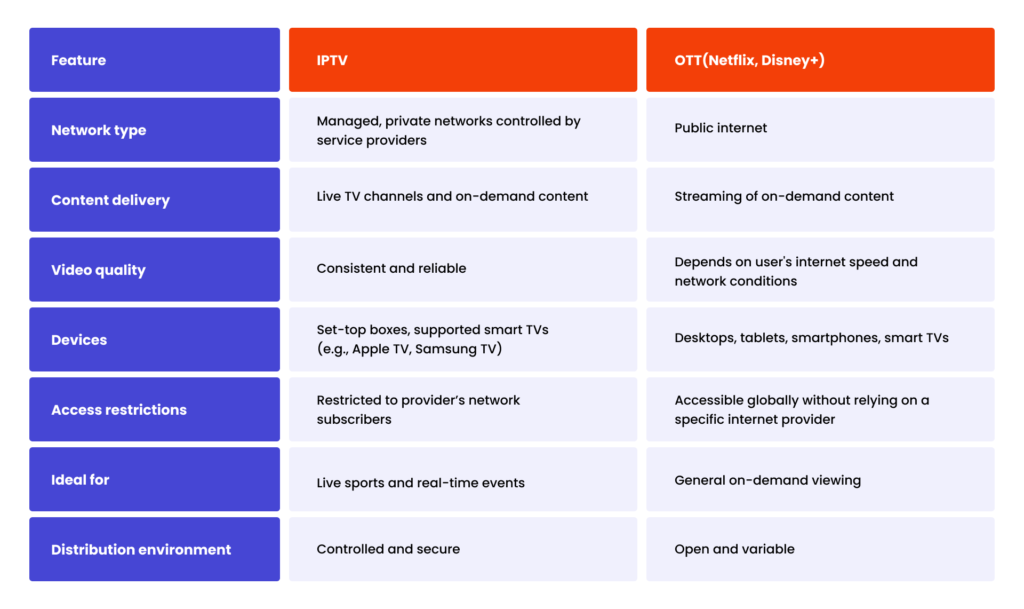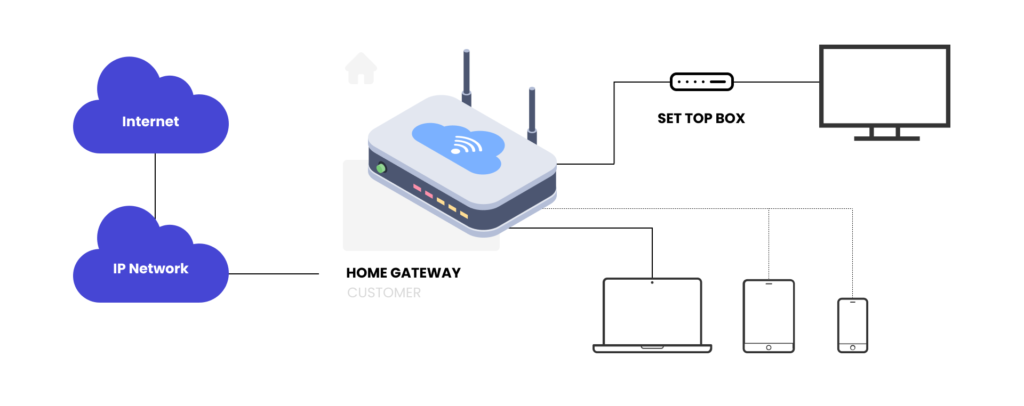IPTV app development: what every media business should know before investing
Today, many companies are locked in a fierce battle for audience attention. Viewers no longer tolerate rigid scheduling or device limitations – they expect instant access to high-quality content on their terms, anywhere and anytime. When these expectations aren’t met, they simply move on to competitors who deliver the experience they demand.
IPTV technology isn’t just another distribution method – it’s the bridge connecting traditional broadcasting with the freedom modern viewers crave. By delivering television over internet protocols, IPTV software transforms passive viewers into engaged audiences who interact with content on their smartphones during commutes, tablets in cafés, and smart TVs at home.
The numbers don’t lie: By 2028, nearly 585 million households worldwide will embrace IPTV connections, a striking 25.75% increase from 2023.
If you are planning IPTV app development, this article provides all the essential information you need before you start. We’ve prepared a complete guide on navigating the technical landscape, avoiding costly development pitfalls, and implementing a revenue-generating monetisation strategy.
What is IPTV?
IPTV (Internet Protocol Television) is a system that delivers television content via Internet Protocol (IP) networks. Unlike traditional broadcasting through satellite or cable TV, IPTV uses IP networks, typically controlled and managed by service providers, ensuring stable and consistent quality.
Unlike regular TV, the IPTV system gives viewers remote control over what they watch and when.
IPTV can deliver:
- Linear (live) channels: Traditional scheduled programming, similar to cable TV.
- On-demand content (VOD): Allowing viewers some flexibility in choosing when to watch.
IPTV vs OTT: what is the difference?

How does an IPTV app work?

An IPTV system delivers television content through streaming protocols rather than traditional broadcast methods. The process works through several specific steps:
Content preparation
Television shows, movies, and live broadcasts are digitised and encoded into formats suitable for internet transmission. Content providers compress these files to balance quality with bandwidth requirements.
Content storage
The encoded programs are stored on powerful servers, creating a digital library that users can access on demand. For live TV channels, the content undergoes real-time encoding before distribution.
Content delivery
When viewers request specific content, the IPTV app retrieves it from servers and sends it through a managed network. Live TV uses multicast transmission (one stream to many viewers simultaneously), while on-demand videos use unicast connections (individual streams for each viewer).
Network transportation
The digital content travels through private managed networks (offering consistent quality) or the public internet, reaching viewers’ homes via broadband connections.
User reception
Viewers access content through set-top boxes, smart TVs, or applications on computers and mobile devices. These endpoints decode the incoming data packets, converting them into viewable video and audio.
Playback control
Users navigate content through an electronic program guide or app interface, allowing them to select channels, search for programmes, and control playback functions like pause, rewind, and record.
To enjoy the IPTV app, users need a reliable internet connection (10+ Mbps recommended for HD content), a compatible device, and access credentials from their service provider.
Benefits of IPTV app development
Investing in IPTV app development offers media businesses significant advantages over traditional broadcasting methods. Here are the key benefits that make the IPTV system a compelling investment:
- Global audience reach: Your video content can expand beyond traditional broadcasting’s geographical limitations, connecting with a broader audience worldwide without complex infrastructure requirements.
- Enhanced viewer experience: You can deliver content when and where your target audiences want it, creating personalised experiences that build stronger user engagement, viewer relationships, and foster long-term loyalty.
- Versatile content delivery: Your content investment delivers more significant returns by offering multiple formats (live, on-demand, time-shifted) through a single unified app.
- Data-driven decision making: You gain insights into viewing patterns and preferences, allowing smarter content acquisition decisions based on viewer behaviour.
- Diversified revenue streams: Flexible monetisation models, such as subscriptions, advertising, and pay-per-view options, can create multiple income sources for your business.
- Cost-effective distribution: You can reduce distribution costs compared to traditional broadcasting while leveraging existing internet networks, eliminating satellite or cable transmission expenses.
- Direct customer relationships: You eliminate intermediaries to build first-party relationships with viewers, gathering valuable data while creating direct communication channels.
- Scalable growth potential: Your app can easily expand to accommodate growth without the significant infrastructure investments traditional broadcasting requires.
Key IPTV business models
The right business model is crucial for sustainable growth when planning IPTV app development. Here are the most effective monetisation strategies being implemented by successful IPTV providers worldwide:
Subscription Video on Demand (SVOD)
This approach offers viewers a complete content library for a recurring monthly or annual fee. It creates predictable revenue streams and encourages long-term customer relationships.
Pay-Per-View model (PPV)
Users pay one-time fees to access specific premium content, which is particularly effective for high-demand live events like sports competitions or concerts.
For example, Sky Sport Box Office across Europe offers exclusive sporting events through its IPTV services with one-time purchase options, generating substantial revenue from must-see content.
Transactional Video on Demand (TVOD)
This IPTV business model allows viewers to rent or purchase individual content pieces without subscription commitments.
Advertised Video on Demand (AVOD)
Content is offered free or at reduced cost to viewers while generating revenue through targeted advertising placements.
Hybrid monetisation
Many successful IPTV platforms combine multiple business models, offering basic ad-supported tiers alongside premium subscription options.
For example, Swisscom TV in Switzerland combines subscription packages with TVOD options and integrates third-party streaming services to maximise revenue across different target audience segments.
B2B enterprise solutions
Beyond consumer markets, IPTV systems offer opportunities in business environments like hotels and corporate offices.
An example is LG Pro:Centric, a smart IPTV platform used in hospitality and healthcare sectors. It allows hotels, hospitals, and corporate campuses to deliver personalised content, interactive services, and branded user experiences directly to in-room TVs, while integrating with property management and patient engagement systems.
Want expert support for your IPTV app development?
Learn moreIPTV development: how to start your own business
With the growing demand for IPTV services we described earlier, entrepreneurs and media companies are increasingly interested in entering this space. Here’s a practical roadmap to building your own IPTV business:
Research your market and find your niche
Before jumping in, take time to understand who you’ll serve. Are you targeting sports enthusiasts who never want to miss a game? Movie buffs looking for indie films not available on mainstream apps? Or perhaps expatriates seeking video content from their home countries?
The market is growing impressively, but success comes from finding your niche.
Think of it like a restaurant business: you don’t need to be a massive chain offering everything; you can be the beloved local spot known for doing one thing exceptionally well. Some successful IPTV providers built their business by focusing exclusively on documentary media content before expanding to broader offerings.
Use reliable technology
The development process is crucial, and it starts by selecting technology. Your technology must be as dependable as old-fashioned television but as flexible as modern streaming. When viewers press “play,” they expect instant results, not buffering circles or error messages.
Consider starting with established white-label custom IPTV solutions for faster market entry. Your infrastructure should include Virtual Private Servers for seamless streaming management, video encoding software, Content Delivery Networks, and robust security protocols.
Moreover, you must consider scalability, allowing for business growth and adding new features without significant infrastructure overhauls.
Choose your business model
We’ve discussed various business models earlier, but selecting the right one depends on understanding your users’ preferences. Some primary IPTV streaming services bet entirely on subscriptions, while others choose advertising. Many successful apps today combine both approaches.
Your choice affects everything downstream, from promoting your service to designing your user interface. A subscription service emphasises content exclusivity and quality, while ad-supported apps focus on maximising viewing time.
Navigate legal requirements
Let’s be honest – legal requirements aren’t the exciting part of launching your IPTV service, but ignoring them is like driving without a license. You’ll need proper content protection and rights for everything in your library, and no, regular TV broadcasting rights don’t automatically cover streaming platforms.
You’ll also need to protect viewer data (especially in Europe with those strict GDPR rules), create clear terms of service, and register with media authorities in many places. Some countries even require specific amounts of local video content in your catalog. Think of legal compliance as insurance – it seems expensive until you need it.
Develop a user-friendly IPTV app
The best content in the world won’t matter if viewers can’t find it easily. Your interface should feel intuitive from the first use. Popular streaming services make finding something to watch effortless compared to navigating traditional cable menus.
Test your interface with real users before launch. Check how they interact with it and where they get confused. Sometimes, a simple location change of the button can increase viewership.
Launch and grow smartly
Don’t try to conquer the whole market on day one. Instead, start small by inviting a limited group of users to try your IPTV app. Think of it as a test drive before the full launch – these early users will tell you what works and what doesn’t. When they spot missed issues, you can fix them before they become more significant problems affecting thousands of customers.
Build credibility
Show potential subscribers that real people are already enjoying your service. Nothing convinces a hesitant customer like hearing another viewer say, “I love this platform!” Share genuine user feedback and viewing stats, and highlight partnerships with content creators they recognise. And remember – a free trial is your best sales tool. Once people experience your app without risking their money, they’ll likely pull out their credit card when the trial ends.
Ready to build an IPTV app that delivers?
An IPTV development process requires more than just good code – it demands a solid mix of technical expertise and business understanding. IPTV app developers face a real challenge: delivering the best solution that meets business goals, handles technical complexity, and keeps users happy.
The good news? You don’t have to start from scratch.
At Spyrosoft, we help media companies build reliable, scalable IPTV solutions ready for the real world. Our skilled developers combine deep industry knowledge with technical know-how to create apps that ensure seamless streaming, even during the busiest moments. If it sounds interesting, just check out our offer.
About the author
Contact us



![[thumbnail] media and entertainment - 10 features for user-friendly platform-min](https://spyro-soft.com/wp-content/uploads/2025/03/thumbnail-media-and-entertainment-10-features-for-user-friendly-platform-min-1024x655.jpg)
![[thumbnail] media and entertainment - VOD vs OTT_ what is the difference](https://spyro-soft.com/wp-content/uploads/2025/04/thumbnail-media-and-entertainment-vod-vs-ott_-what-is-the-difference-min-1024x655.jpg)
![[thumbnail] media and entertainment - user privacy and personalisation in OTT streaming services](https://spyro-soft.com/wp-content/uploads/2025/03/thumbnail-media-and-entertainment-privacy-and-personalisation-in-ott-platforms-min-1024x655.jpg)